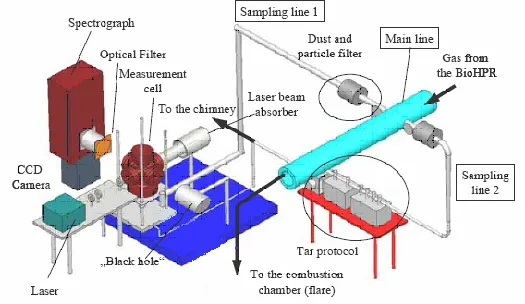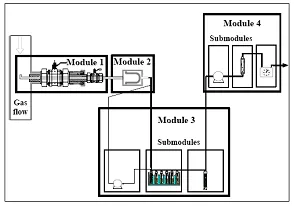Teermessungen
Object of research
One of the main problems during the gasification of biomass is the formation of heavy hydrocarbons, the so-called tars, which influence the gasification process and have an impact on the further use of the product gas for energy production, as for example in fuel cells or microturbines.
The aim of the research is the online measurement of the tar content of the product gas from the BioHPR together with the composition of the product gas. For this reason an innovative laser system should be developed, giving the possibility of an online definition of the tar content of this product gas. Parallel to it, a standarised technique, the Tar Protocol, as well as GC-FID measurements will be used in order to compare between the results of these measurement procedures.
Experimental setup
The experimental setup consists of an Nd:YAG pulsed Laser, a spectrograph and a CCD Camera, which is connected with a Computer and can take and save pictures continuously during the experiments. According to the combination of signals based on Fluorescence and Raman spectroscopy and with the help of specific software, it is possible to derive information about the concentration of each component in the product gas as well as the tar content of it.
In the following figure there is a diagram of the modular sampling train for the Tar protocol. The full Guideline can be downloaded at www.tarweb.net.
Module 1: gas preconditioning
Module 2: particle collection
Module 3: tar collection
Module 4: volume measurement
The product gas, which is kept under a constant temperature, enters the Guideline and after the treatment follows the analysis of the samples, where it is possible to measure tars either gravimetrically or with the help of Gas Chromatography through a specific Flame Ionisation Detector (GC-FID).
Goals
The target of the research is to determine the amount of tars (qualitative and quantitative) which are produced through the gasification process in an allothermal Gasifier as the Biomass Heatpipe Reformer (BioHPR). Furthermore, the parameters of the gasification process which influence the tar content and the quality of the product gas will be taken into consideration.

